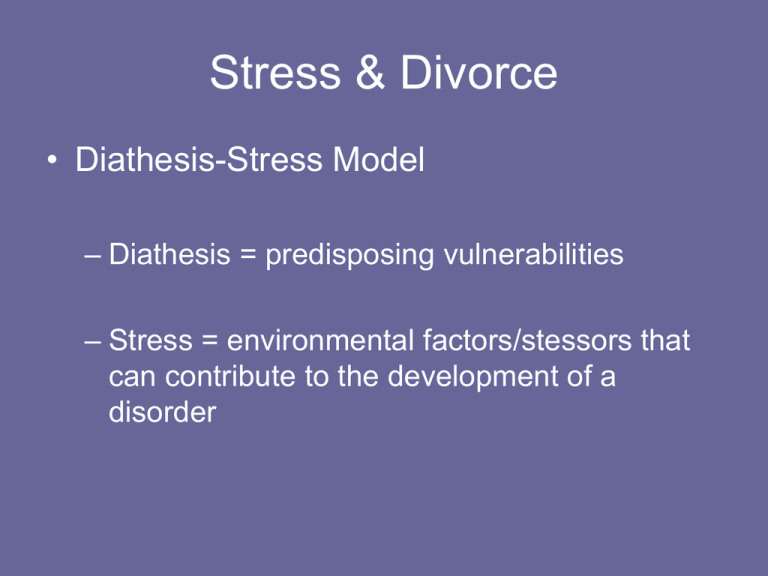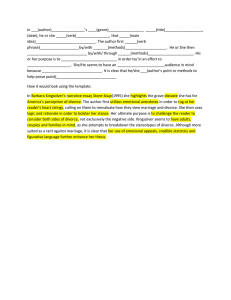Stress & Divorce • Diathesis-Stress Model
advertisement

Stress & Divorce • Diathesis-Stress Model – Diathesis = predisposing vulnerabilities – Stress = environmental factors/stessors that can contribute to the development of a disorder Diathesis stress heuristic • Heuristic = aid to learning • 100 units to become schizophrenic • Units come from 2 sources – Individual (diathesis) – environment Heuristic cont’ • stressors can have cumulative effect • Stressors in childhood are often grouped together • Implies that anyone may develop a disorder Genetic Studies • Twin studies • “Double-whammy” effect • Adopted children Childhood stressors • Mandatory school attendance • • • • Required for all children Majority of referrals Age 6 peak for referrals What makes school a stressor? Implications 1. Child referrals often involve schoolrelated difficulties 2. Child interventions may need to take place in school 3. Clinicians may need to mediate 4. School environments are not the same 5. Need to know about legislation Marital conflict and divorce • Possible stresses associated with divorce: Problems assoc. with divorce 1. Increases in aggressive and noncompliant behavior (boys) 2. Girls – findings less clear. May have delayed problems 3. Gender differences – WHY? 4. Marital conflict is key, not just parental separation Developmental status & divorce • • • • • Preschoolers Early school age Older school age Adolescents remarriage Child characteristics that may impact adjustment 1. Temperament 2. Marital precursors Block et al. study • • • • • • Longitudinal study Assessed kids at ages 3, 4, 5, 7, 11, 14 Interviewed mothers Collected measures from teachers Compared divorced and intact families at age 14 Cause & effect??? Cause & Effect • Recent Gottman study – Babies & marital conflict – Possible hypotheses Hetherington et al. (1988) • What factors make a difference in divorce/marital transitions and child adjustment? 1. Individual risk & vulnerability – Child characteristics – Adult characteristics 2. Family composition 3. Parental stress and strain 4. Family process What to say to children • Set aside time to meet as family, tell together to reduce blame. • Tell child it is not their fault. • Tell child it is final (avoid false hopes) • Provide reassurance – Basic needs – Continuing relationship with both parents, siblings, etc. How to help children through divorce • • • • • • Both parents stay involved Stop fighting; get along Support time with each parent Communicate directly between parents Say nice things about other parent Self-care/address own mental health issues Tasks for children of divorce 1. Acknowledge marital disruption 2. Regain sense of direction and freedom to maintain routine 3. Deal with loss and feelings of rejection 4. Forgive parents, work through anger 5. Accept permanence of divorce 6. Resolve relationship issues

